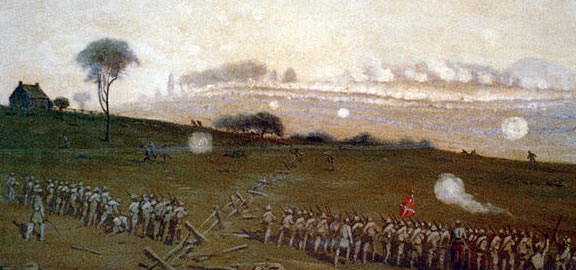On the third and final day of fighting, Confederate General Robert E. Lee wished to maintain the offensive and crush the Union Army. His plan was nearly identical to the day before - Longstreet would attack the Union left flank and Ewell would assault and occupy Culp's Hill on the Union right flank.
Failure at Culp's Hill
At around 4:00 A.M. on the 3rd, however, Lee's plans were foiled when Union forces launched an artillery bombardment on the lower portion of Culp's Hill that the Confederates had occupied the day before, forcing the Confederates there into battle. By 11:00 A.M., Confederate forces had gained little, if any, ground and suffered significant casualties. The failure at Culp's Hill required Lee to change his plans. He decided on an artillery bombardment on the Union line at Cemetery Ridge, before sending a massive infantry charge, which came to be known as Pickett's Charge.
Preparing for a Massive Assault
The artillery bombardment, however, proved relatively ineffective, even though the 150 guns used represented the largest such bombardment in the entire war. The massive amounts of smoke produced from the thundering cannons obscured targets, causing gunners to overshoot. Union forces eventually countered with 80 cannon of their own, adding to the chaos and confusion. To save ammunition, Union Brigadier General Henry Hunt ordered cannon fire to be gradually phased out, confusing Confederate gunners into believing they had been destroyed. The Confederate artillery bombardment was totally unsuccessful, and failed in its objective to soften Union defenses before the ill-fated infantry assault.
Pickett's Charge
 |
Pickett's Charge up Cemetery Ridge |
At 3:00 in the afternoon, some 12,500 Confederate soldiers under the command of James Longstreet started their nearly mile-long uphill march to Union positions on Cemetery Ridge behind a stone wall. Interestingly, Longstreet had desperately tried to convince Lee to abandon the assault, believing it to be the equivalent of suicide, but Lee refused, intent on piercing the center of the Union line. Major General George Pickett's brigade was chosen to lead the charge, giving rise to the event's popular name: Pickett's Charge.
Unimaginable Carnage
The Confederates marching through the open fields were easy targets for Union guns and cannons, which fired from all directions on the nine brigades of Rebel soldiers. Huge gaps quickly formed in the Confederate lines from devastating artillery fire that killed or wounded groups of soldiers in a single blast. The carnage quickly demoralized the Confederate soldiers, many of whom turned around and ran. Others were gunned down by musket fire as they neared the stone wall. "Pickett's Charge" was a massacre. Of the 12,500 soldiers who advanced upon Cemetery Ridge, over half were killed or wounded. Union forces suffered about 1,500 casualties. Between 3,000 and 4,000 Confederate soldiers were reportedly captured. Lee, fully aware of the massacre, and worried about a Union counterattack, attempted to rally his soldiers crying out "it's all my fault," but there would be no rally, nor would there be a serious counterattack against the retreating Rebels.
A Decisive Union Victory in the Largest Battle in American History
On July 4, a truce was called so each side could collect their dead and wounded. In the July heat, the stench of the decomposing bodies which littered the fields caused many in Gettysburg to become violently ill.
As many as 51,000 casualties were documented at the end of the Battle of Gettysburg, with the Confederacy suffering as many as 28,000, and the Union about 23,000. Lee's Army of Northern Virginia retreated back to Virginia and would never fight again on Union soil. President Abraham Lincoln urged General Meade to pursue and attack the reeling Confederates, but the half-hearted pursuit proved ineffective and the Confederates escaped to Virginia. Meade would be soundly criticized for failing to deliver a decisive blow to the Confederates in their retreat.